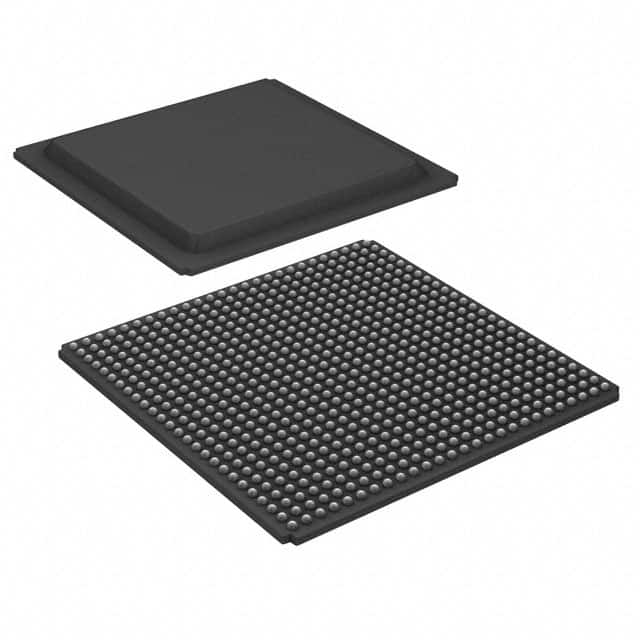XC7K160T-2FBG676C
Product Overview
Category
The XC7K160T-2FBG676C belongs to the category of Field-Programmable Gate Arrays (FPGAs).
Use
FPGAs are integrated circuits that can be programmed after manufacturing, allowing for flexible and customizable digital logic designs. The XC7K160T-2FBG676C is specifically designed for high-performance applications.
Characteristics
- High processing power
- Configurable logic blocks
- On-chip memory
- Flexible I/O capabilities
- Low power consumption
Package
The XC7K160T-2FBG676C comes in a BGA (Ball Grid Array) package.
Essence
The essence of the XC7K160T-2FBG676C lies in its ability to provide a versatile platform for implementing complex digital systems with high performance and flexibility.
Packaging/Quantity
The XC7K160T-2FBG676C is typically packaged individually and is available in various quantities depending on the manufacturer's specifications.
Specifications
- FPGA Family: Kintex-7
- Device Type: XC7K160T
- Logic Cells: 159,200
- DSP Slices: 480
- Block RAM: 4,860 Kb
- Maximum I/O Pins: 500
- Operating Voltage: 1.0V - 1.2V
- Operating Temperature Range: -40°C to 100°C
Detailed Pin Configuration
The XC7K160T-2FBG676C has a total of 676 pins arranged in a specific configuration. For detailed pin assignments and their functions, please refer to the manufacturer's datasheet or user guide.
Functional Features
- High-speed data processing
- Configurable logic resources
- Integrated memory blocks
- Flexible I/O interfaces
- Built-in DSP capabilities
Advantages and Disadvantages
Advantages
- High processing power for demanding applications
- Flexibility to implement custom logic designs
- Low power consumption compared to traditional ASICs
- Ability to reprogram the FPGA after manufacturing
Disadvantages
- Higher cost compared to fixed-function integrated circuits
- Longer development time due to the need for programming and verification
- Limited availability of alternative models with similar specifications
Working Principles
The XC7K160T-2FBG676C operates based on the principles of configurable logic. The FPGA consists of an array of programmable logic blocks interconnected through configurable routing resources. These logic blocks can be programmed to implement various digital functions, allowing for the creation of complex systems.
Detailed Application Field Plans
The XC7K160T-2FBG676C finds applications in a wide range of fields, including: - Telecommunications - Aerospace and defense - Industrial automation - Medical devices - High-performance computing - Image and video processing
Detailed and Complete Alternative Models
Some alternative models that offer similar capabilities to the XC7K160T-2FBG676C include: - XC7K325T-2FFG900C - XC7K410T-1FFG900C - XC7K480T-2FFG901C
These models provide varying levels of logic capacity, I/O capabilities, and performance to suit different application requirements.
In conclusion, the XC7K160T-2FBG676C is a high-performance FPGA belonging to the Kintex-7 family. It offers flexibility, configurability, and powerful processing capabilities, making it suitable for a wide range of applications. While it has advantages such as reprogrammability and low power consumption, it also has limitations in terms of cost and development time. Nonetheless, the XC7K160T-2FBG676C remains a valuable tool for implementing complex digital systems in various industries.
10個與XC7K160T-2FBG676C在技術方案中應用相關的常見問題與解答
Sure! Here are 10 common questions and answers related to the application of XC7K160T-2FBG676C in technical solutions:
Question: What is XC7K160T-2FBG676C?
Answer: XC7K160T-2FBG676C is a specific model of Xilinx's Kintex-7 FPGA (Field-Programmable Gate Array) family, which offers high-performance programmable logic solutions for various applications.Question: What are the key features of XC7K160T-2FBG676C?
Answer: Some key features of XC7K160T-2FBG676C include 160,000 logic cells, 12.5 Gbps transceivers, 4.9 Mb block RAM, and 500 MHz clock frequency.Question: What are the typical applications of XC7K160T-2FBG676C?
Answer: XC7K160T-2FBG676C can be used in a wide range of applications such as wireless communication, video processing, industrial control systems, aerospace, and defense.Question: How can XC7K160T-2FBG676C be programmed?
Answer: XC7K160T-2FBG676C can be programmed using Xilinx's Vivado Design Suite, which provides a comprehensive development environment for FPGA designs.Question: Can XC7K160T-2FBG676C be used for real-time signal processing?
Answer: Yes, XC7K160T-2FBG676C is capable of real-time signal processing due to its high-speed transceivers and powerful programmable logic resources.Question: Is XC7K160T-2FBG676C suitable for high-bandwidth data communication?
Answer: Absolutely, XC7K160T-2FBG676C's 12.5 Gbps transceivers make it well-suited for high-bandwidth data communication applications such as Ethernet or PCIe.Question: Can XC7K160T-2FBG676C interface with external memory devices?
Answer: Yes, XC7K160T-2FBG676C supports various memory interfaces like DDR3, DDR4, and QDR to enable efficient data storage and retrieval.Question: What are the power requirements for XC7K160T-2FBG676C?
Answer: The power requirements for XC7K160T-2FBG676C can be found in the device datasheet provided by Xilinx.Question: Are there any development boards available for XC7K160T-2FBG676C?
Answer: Yes, Xilinx offers development boards like the Kintex-7 KC705 Evaluation Kit that can be used for prototyping and testing designs based on XC7K160T-2FBG676C.Question: Where can I find more information about XC7K160T-2FBG676C?
Answer: You can find detailed technical documentation, application notes, and reference designs on Xilinx's official website or by referring to the XC7K160T-2FBG676C datasheet.


